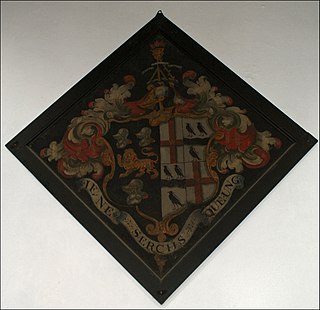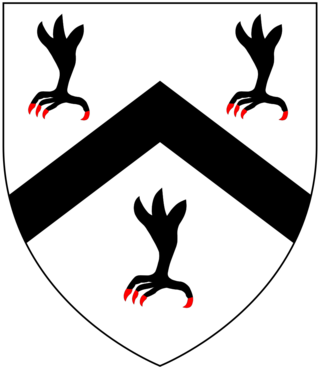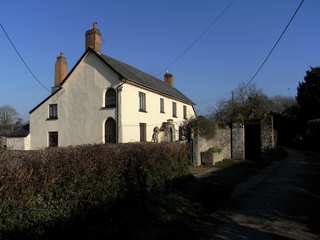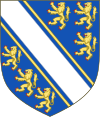
In heraldry, the field (background) of a shield can be divided into more than one area, or subdivision, of different tinctures, usually following the lines of one of the ordinaries and carrying its name. Shields may be divided this way for differencing or for purposes of marshalling, or simply for style. The lines that divide a shield may not always be straight, and there is a system of terminology for describing patterned lines, which is also shared with the heraldic ordinaries.

In heraldry, an ordinary is one of the two main types of charges, beside the mobile charges. An ordinary is a simple geometrical figure, bounded by straight lines and running from side to side or top to bottom of the shield. There are also some geometric charges known as subordinaries, which have been given lesser status by some heraldic writers, though most have been in use as long as the traditional ordinaries. Diminutives of ordinaries and some subordinaries are charges of the same shape, though thinner. Most of the ordinaries are theoretically said to occupy one-third of the shield; but this is rarely observed in practice, except when the ordinary is the only charge.

In heraldry, an escutcheon is a shield that forms the main or focal element in an achievement of arms. The word can be used in two related senses. In the first sense, an escutcheon is the shield upon which a coat of arms is displayed. In the second sense, an escutcheon can itself be a charge within a coat of arms.

A funerary hatchment is a depiction within a black lozenge-shaped frame, generally on a black (sable) background, of a deceased's heraldic achievement, that is to say the escutcheon showing the arms, together with the crest and supporters of his family or person. Regimental Colours and other military or naval emblems are sometimes placed behind the arms of military or naval officers. Such funerary hatchments, generally therefore restricted in use to members of the nobility or armigerous gentry, used to be hung on the wall of a deceased person's house, and were later transferred to the parish church, often within the family chapel therein which appertained to the manor house, the family occupying which, generally being lord of the manor, generally held the advowson of the church. In Germany, the approximate equivalent is a Totenschild, literally "shield of the dead".
In English law, baron and feme is a phrase used for husband and wife, in relation to each other, who were accounted as one person by coverture. Hence, by the old law of evidence, the one party was excluded from giving evidence for or against the other in civil questions, and a relic of this is still preserved in criminal law.

In heraldry and heraldic vexillology, a blazon is a formal description of a coat of arms, flag or similar emblem, from which the reader can reconstruct the appropriate image. The verb to blazon means to create such a description. The visual depiction of a coat of arms or flag has traditionally had considerable latitude in design, but a verbal blazon specifies the essentially distinctive elements. A coat of arms or flag is therefore primarily defined not by a picture but rather by the wording of its blazon. Blazon is also the specialized language in which a blazon is written, and, as a verb, the act of writing such a description. Blazonry is the art, craft or practice of creating a blazon. The language employed in blazonry has its own vocabulary, grammar and syntax, which becomes essential for comprehension when blazoning a complex coat of arms.

Edmund Braye, 1st Baron Braye, of Eaton Bray in Bedfordshire, was an English peer.

Fulk Bourchier, 10th Baron FitzWarin was the son and heir of William Bourchier, 9th Baron FitzWarin (1407–1470) and the father of John Bourchier, 1st Earl of Bath. He was feudal baron of Bampton in Devon.
William Courtenay, 1st Viscount Courtenay, also de jure 7th Earl of Devon, was a British peer. He was the son of William Courtenay, 6th Earl of Devon and 2nd Baronet Courtenay, and Lady Anne Bertie.

Dexter and sinister are terms used in heraldry to refer to specific locations in an escutcheon bearing a coat of arms, and to the other elements of an achievement. Dexter indicates the right-hand side of the shield, as regarded by the bearer, i.e. the bearer's proper right, and to the left as seen by the viewer. Sinister indicates the left-hand side as regarded by the bearer – the bearer's proper left, and to the right as seen by the viewer. In vexillology, the equivalent terms are hoist and fly.

Sir John III Chichester of Hall was member of parliament for Lostwithiel in Cornwall in 1624.

Richard Fortescue of Filleigh, North Devon was an English Member of Parliament and prominent land-owner and member of the Devonshire gentry, ancestor to the Earls Fortescue.

Robert Carey, lord of the manor of Clovelly in North Devon, was Member of Parliament for Barnstaple, Devon, in October 1553 and served as Sheriff of Devon in 1555–56. He served as Recorder of Barnstaple after 1560. Along with several other members of the Devonshire gentry then serving as magistrates he died of gaol fever at the Black Assize of Exeter 1587. His large monument survives in Clovelly Church.

Hall is a large estate within the parish and former manor of Bishop's Tawton, Devon. It was for several centuries the seat of a younger branch of the prominent and ancient North Devon family of Chichester of Raleigh, near Barnstaple. The mansion house is situated about 2 miles south-east of the village of Bishop's Tawton and 4 miles south-east of Barnstaple, and sits on a south facing slope of the valley of the River Taw, overlooking the river towards the village of Atherington. The house and about 2,500 acres of surrounding land continues today to be owned and occupied by descendants, via a female line, of the Chichester family. The present Grade II* listed neo-Jacobean house was built by Robert Chichester between 1844 and 1847 and replaced an earlier building. Near the house to the south at the crossroads of Herner the Chichester family erected in the 1880s a private chapel of ease which contains mediaeval woodwork saved from the demolished Old Guildhall in Barnstaple.

The landed gentry and nobility of Devonshire, like the rest of the English and European gentry, bore heraldic arms from the start of the age of heraldry circa 1200–1215. The fashion for the display of heraldry ceased about the end of the Victorian era (1901) by which time most of the ancient arms-bearing families of Devonshire had died out, moved away or parted with their landed estates.

Ash in the parish of Braunton in North Devon is a historic estate listed in the Domesday Book. The present mansion, known as The Ash Barton estate is a Grade II* listed building.

Langley was a historic estate in the parish of Yarnscombe, Devon, situated one mile north-east of the village of Yarnscombe. It was long the seat of a junior branch of the Pollard family of Way in the parish of St Giles in the Wood, Devon, 3 miles to the south.

Sir William Huddesfield of Shillingford St George in Devon, was Attorney General for England and Wales to Kings Edward IV (1461–1483) and Henry VII (1485–1509). He built the tower of St George's Church, Shillingford.

The large parish church of St Giles, which is in the village of St Giles in the Wood, Devon, England, came into being in 1309. When it was restored in 1862–3, many monuments were retained, including the monument and effigy of Thomas Chafe of Dodscott, three monumental brasses, of Alenora Pollard, Margaret Rolle of Stevenstone and a small brass of her husband John Rolle (d.1570). There are also 19th- and 20th-century monuments to the Rolle family.

Moor Hays is a historic estate in the parish of Cullompton in Devon, England. It is stated incorrectly to be in the nearby parish of Burlescombe in Tristram Risdon's Survey of Devon. The estate is not to be confused with Moor Hayes in the parish of Washfield, about 3 miles north-west of Tiverton, another ancient farmstead, which since 2005 has been the site of a large housing estate named "Moorhayes".
























